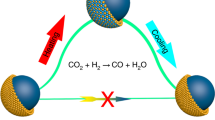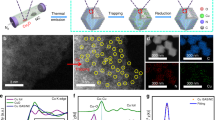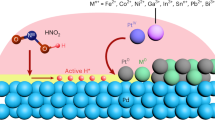Abstract
Structurally ordered intermetallic nanocrystals (NCs) and single-atom catalysts (SACs) are two emerging catalytic motifs for sustainable chemical production and energy conversion. However, both have synthetic limitations which can lead to the aggregation of NCs or metal atoms. Single-atom alloys (SAAs), which contain isolated metal atoms in a host metal, can overcome the aggregation concern because of the thermodynamic stabilization of single atoms on host metal surfaces. Here we report a direct solution-phase synthesis of Cu/CuAu core/shell NCs with tunable SAA layers. This synthesis can be extended to other Cu/CuM (M = Pt, Pd) systems, in which M atoms are isolated in the copper host. Using this method, the density of SAAs on a copper surface can be controlled, resulting in both low and high densities of single atoms. Alloying gold into the copper matrix introduced ligand effects that optimized the chemisorption of *NO3 and *N. As a result, the densely packed Cu/CuAu material demonstrated a high selectivity toward NH3 from the electrocatalytic nitrate reduction reaction with an 85.5% Faradaic efficiency while maintaining a high yield rate of 8.47 mol h−1 g−1. This work advances the design of atomically precise catalytic sites by creating core/shell NCs with SAA atomic layers, opening an avenue for broad catalytic applications.

This is a preview of subscription content, access via your institution
Access options
Subscribe to this journal
Receive 12 digital issues and online access to articles
$119.00 per year
only $9.92 per issue
Buy this article
- Purchase on Springer Link
- Instant access to full article PDF
Prices may be subject to local taxes which are calculated during checkout





Similar content being viewed by others
Data availability
The data supporting the finding of the study are available in the paper and its Supplementary Information. Source data are provided with this paper.
Change history
22 March 2023
A Correction to this paper has been published: https://doi.org/10.1038/s44160-023-00295-6
References
van der Hoeven, J. E. S. et al. Unlocking synergy in bimetallic catalysts by core–shell design. Nat. Mater. 20, 1216–1220 (2021).
Wu, P. et al. Harnessing strong metal–support interactions via a reverse route. Nat. Commun. 11, 3042 (2020).
Gawande, M. B. et al. Core–shell nanoparticles: synthesis and applications in catalysis and electrocatalysis. Chem. Soc. Rev. 44, 7540–7590 (2015).
Zhao, X. & Sasaki, K. Advanced Pt-based core–shell electrocatalysts for fuel cell cathodes. Acc. Chem. Res. 55, 1226–1236 (2022).
Yang, X. et al. Modulating electronic structure of an Au-nanorod-core–PdPt-alloy-shell catalyst for efficient alcohol electro-oxidation. Adv. Energy Mater. 11, 2100812 (2021).
Wang, X. et al. Palladium–platinum core–shell icosahedra with substantially enhanced activity and durability towards oxygen reduction. Nat. Commun. 6, 7594 (2015).
Wang, H. et al. Significantly enhanced overall water splitting performance by partial oxidation of Ir through Au modification in core–shell alloy structure. J. Am. Chem. Soc. 143, 4639–4645 (2021).
Li, M. et al. Exclusive strain effect boosts overall water splitting in PdCu/Ir core/shell nanocrystals. Angew. Chem. Int. Ed. 60, 8243–8250 (2021).
Zhuang, T.-T. et al. Steering post-C–C coupling selectivity enables high efficiency electroreduction of carbon dioxide to multi-carbon alcohols. Nat. Catal. 1, 421–428 (2018).
Luc, W. et al. Ag–Sn bimetallic catalyst with a core–shell structure for CO2 reduction. J. Am. Chem. Soc. 139, 1885–1893 (2017).
Liu, C. et al. Favorable core/shell interface within Co2P/Pt nanorods for oxygen reduction electrocatalysis. Nano Lett. 18, 7870–7875 (2018).
Zhang, S. et al. Monodisperse core/shell Ni/FePt nanoparticles and their conversion to Ni/Pt to catalyze oxygen reduction. J. Am. Chem. Soc. 136, 15921–15924 (2014).
Ji, Y. et al. Selective CO-to-acetate electroreduction via intermediate adsorption tuning on ordered Cu–Pd sites. Nat. Catal. 5, 251–258 (2022).
Yang, C.-L. et al. Sulfur-anchoring synthesis of platinum intermetallic nanoparticle catalysts for fuel cells. Science 374, 459–464 (2021).
Wang, D. et al. Structurally ordered intermetallic platinum–cobalt core–shell nanoparticles with enhanced activity and stability as oxygen reduction electrocatalysts. Nat. Mater. 12, 81–87 (2013).
Wang, A., Li, J. & Zhang, T. Heterogeneous single-atom catalysis. Nat. Rev. Chem. 2, 65–81 (2018).
Yang, X.-F. et al. Single-atom catalysts: a new frontier in heterogeneous catalysis. Acc. Chem. Res. 46, 1740–1748 (2013).
Liu, J.-C., Xiao, H. & Li, J. Constructing high-loading single-atom/cluster catalysts via an electrochemical potential window strategy. J. Am. Chem. Soc. 142, 3375–3383 (2020).
Chen, Y. et al. Single-atom catalysts: synthetic strategies and electrochemical applications. Joule 2, 1242–1264 (2018).
Zhang, T., Walsh, A. G., Yu, J. & Zhang, P. Single-atom alloy catalysts: structural analysis, electronic properties and catalytic activities. Chem. Soc. Rev. 50, 569–588 (2021).
Kaiser, S. K., Chen, Z., Faust Akl, D., Mitchell, S. & Pérez-Ramírez, J. Single-atom catalysts across the periodic table. Chem. Rev. 120, 11703–11809 (2020).
Hannagan, R. T., Giannakakis, G., Flytzani-Stephanopoulos, M. & Sykes, E. C. H. Single-atom alloy catalysis. Chem. Rev. 120, 12044–12088 (2020).
Han, A. et al. Isolating contiguous Pt atoms and forming Pt–Zn intermetallic nanoparticles to regulate selectivity in 4-nitrophenylacetylene hydrogenation. Nat. Commun. 10, 3787 (2019).
Feng, Q. et al. Isolated single-atom Pd sites in intermetallic nanostructures: high catalytic selectivity for semihydrogenation of alkynes. J. Am. Chem. Soc. 139, 7294–7301 (2017).
Armbrüster, M. et al. Al13Fe4 as a low-cost alternative for palladium in heterogeneous hydrogenation. Nat. Mater. 11, 690–693 (2012).
Nakaya, Y., Hirayama, J., Yamazoe, S., Shimizu, K.-I. & Furukawa, S. Single-atom Pt in intermetallics as an ultrastable and selective catalyst for propane dehydrogenation. Nat. Commun. 11, 2838 (2020).
Xia, X. H., Wang, Y., Ruditskiy, A. & Xia, Y. N. 25th anniversary article: galvanic replacement: a simple and versatile route to hollow nanostructures with tunable and well-controlled properties. Adv. Mater. 25, 6313–6333 (2013).
González, E., Arbiol, J. & Puntes, V. F. Carving at the nanoscale: sequential galvanic exchange and kirkendall growth at room temperature. Science 334, 1377–1380 (2011).
Chen, F.-Y. et al. Efficient conversion of low-concentration nitrate sources into ammonia on a Ru-dispersed Cu nanowire electrocatalyst. Nat. Nanotechnol. 17, 759–767 (2022).
Wang, Y., Wang, C., Li, M., Yu, Y. & Zhang, B. Nitrate electroreduction: mechanism insight, in situ characterization, performance evaluation, and challenges. Chem. Soc. Rev. 50, 6720–6733 (2021).
Min, B. et al. Powering the remediation of the nitrogen cycle: progress and perspectives of electrochemical nitrate reduction. Ind. Eng. Chem. Res. 60, 14635–14650 (2021).
Rosca, V., Duca, M., de Groot, M. T. & Koper, M. T. M. Nitrogen cycle electrocatalysis. Chem. Rev. 109, 2209–2244 (2009).
Guo, H. et al. Shape-selective formation of monodisperse copper nanospheres and nanocubes via disproportionation reaction route and their optical properties. J. Phys. Chem. C 118, 9801–9808 (2014).
Zhao, J., Chen, B. & Wang, F. Shedding light on the role of misfit strain in controlling core–shell nanocrystals. Adv. Mater. 32, 2004142 (2020).
Kim, D. et al. Electrochemical activation of CO2 through atomic ordering transformations of AuCu nanoparticles. J. Am. Chem. Soc. 139, 8329–8336 (2017).
Wan, J. et al. Defect effects on TiO2 nanosheets: stabilizing single atomic site au and promoting catalytic properties. Adv. Mater. 30, 1705369 (2018).
Gao, Q. et al. Breaking adsorption-energy scaling limitations of electrocatalytic nitrate reduction on intermetallic CuPd nanocubes by machine-learned insights. Nat. Commun. 13, 2338 (2022).
Wu, Z.-Y. et al. Electrochemical ammonia synthesis via nitrate reduction on Fe single atom catalyst. Nat. Commun. 12, 2870 (2021).
Wang, Y., Zhou, W., Jia, R., Yu, Y. & Zhang, B. Unveiling the activity origin of a copper-based electrocatalyst for selective nitrate reduction to ammonia. Angew. Chem. Int. Ed. 59, 5350–5354 (2020).
Wang, Y. et al. Enhanced nitrate-to-ammonia activity on copper-nickel alloys via tuning of intermediate adsorption. J. Am. Chem. Soc. 142, 5702–5708 (2020).
Li, J. et al. Efficient ammonia electrosynthesis from nitrate on strained ruthenium nanoclusters. J. Am. Chem. Soc. 142, 7036–7046 (2020).
Yao, Y., Zhu, S., Wang, H., Li, H. & Shao, M. A spectroscopic study on the nitrogen electrochemical reduction reaction on gold and platinum surfaces. J. Am. Chem. Soc. 140, 1496–1501 (2018).
da Cunha, M. C. P. M., De Souza, J. P. I. & Nart, F. C. Reaction pathways for reduction of nitrate ions on platinum, rhodium, and platinum–rhodium alloy electrodes. Langmuir 16, 771–777 (2000).
Yao, Y., Zhu, S., Wang, H., Li, H. & Shao, M. A spectroscopic study of electrochemical nitrogen and nitrate reduction on rhodium surfaces. Angew. Chem. Int. Ed. 59, 10479–10483 (2020).
Huang, J. et al. Potential-induced nanoclustering of metallic catalysts during electrochemical CO2 reduction. Nat. Commun. 9, 3117 (2018).
Dovgolevsky, E. & Haick, H. Direct observation of the transition point between quasi-spherical and cubic nanoparticles in a two-step seed-mediated growth method. Small 4, 2059–2066 (2008).
Kresse, G. & Furthmüller, J. Efficiency of ab-initio total energy calculations for metals and semiconductors using a plane-wave basis set. Comput. Mater. Sci. 6, 15–50 (1996).
Kresse, G. & Furthmüller, J. Efficient iterative schemes for ab initio total-energy calculations using a plane-wave basis set. Phys. Rev. B 54, 11169–11186 (1996).
Hammer, B., Hansen, L. B. & Nørskov, J. K. Improved adsorption energetics within density-functional theory using revised Perdew–Burke–Ernzerhof functionals. Phys. Rev. B 59, 7413–7421 (1999).
Acknowledgements
H.Y.Z., Q.G., X.H., Y.L. and B.M. acknowledge funding support from the NSF CBET Catalysis CAREER programme (award number 2143710). This research used resources of the Advanced Photon Source, a US Department of Energy (DOE) Office of Science user facility operated for the DOE Office of Science by Argonne National Laboratory under contract number DE-AC02-06CH11357. Q.H. acknowledges the support of the National Research Foundation (NRF) Singapore, under its NRF Fellowship (NRF-NRFF11-2019-0002) and the Singapore Low-carbon Energy Research funding initiative (award number LCERFI01-0017). This research used the beamline 7-BM (QAS) of the National Synchrotron Light Source II, a US DOE Office of Science User Facility operated for the DOE Office of Science by the Brookhaven National Laboratory under contract number DE-SC0012704. S.Z. and S.-W.Y. gratefully acknowledge the financial support for this research provided by the NSF (grant number CBET-2004808). H.S.P and H.X. gratefully acknowledge the financial support of the NSF CAREER programme (CBET-1845531). The computational resource used in this work is provided by the advanced research computing at Virginia Polytechnic Institute and State University.
Author information
Authors and Affiliations
Contributions
Q.G. and H.Y.Z. conceptualized the project. H.Y.Z. supervised the project. Q.G. planned and performed the catalyst synthesis, conducted the electrocatalytic tests, and collected and analysed the data. B.Y., W.Z. and Q.H. collected and analysed the STEM data. H.S.P. and H.X. did the theoretical calculations. X.H., Y.L., Z.Y. and B.M. helped with the synthesis of the catalysts and collected the data. S.-W.Y. and S.Z. helped to perform the DEMS and ATR-SEIRAS measurements. H.Z. performed the EXAFS measurements. L.M. performed the synchrotron X-ray diffraction measurements. Q.G., H.S.P., B.Y., Q.H., H.X. and H.Z. wrote the manuscript. All authors discussed the results and commented on the manuscript.
Corresponding authors
Ethics declarations
Competing interests
The authors declare no competing interests.
Peer review
Peer review information
Nature Synthesis thanks Minna Cao, Peng Zhang and the other, anonymous, reviewer(s) for their contribution to the peer review of this work. Primary handling editor: Alexandra Groves, in collaboration with the Nature Synthesis team.
Additional information
Publisher’s note Springer Nature remains neutral with regard to jurisdictional claims in published maps and institutional affiliations.
Supplementary information
Supplementary Information
Supplementary Figs. 1–34 and Tables 1–4.
Source data
Source Data Fig. 3
Structural characterizations.
Source Data Fig. 4
Electrocatalytic nitrate reduction performance.
Source Data Fig. 5
Density functional theory calculations.
Rights and permissions
Springer Nature or its licensor (e.g. a society or other partner) holds exclusive rights to this article under a publishing agreement with the author(s) or other rightsholder(s); author self-archiving of the accepted manuscript version of this article is solely governed by the terms of such publishing agreement and applicable law.
About this article
Cite this article
Gao, Q., Yao, B., Pillai, H.S. et al. Synthesis of core/shell nanocrystals with ordered intermetallic single-atom alloy layers for nitrate electroreduction to ammonia. Nat. Synth 2, 624–634 (2023). https://doi.org/10.1038/s44160-023-00258-x
Received:
Accepted:
Published:
Issue Date:
DOI: https://doi.org/10.1038/s44160-023-00258-x
This article is cited by
-
Spin polarized Fe1−Ti pairs for highly efficient electroreduction nitrate to ammonia
Nature Communications (2024)
-
Fundamentals and catalytic applications of single-atom alloys
Science China Materials (2024)
-
Better catalysts in a (nut)shell
Nature Reviews Materials (2023)
-
Homogeneous and complex catalysts
Nature Synthesis (2023)
-
Research progress on electrochemical CO2 reduction for Cu-based single-atom catalysts
Science China Materials (2023)



